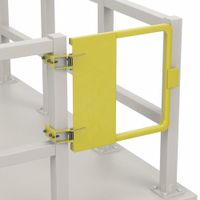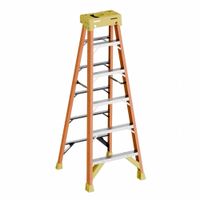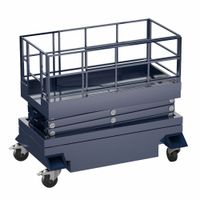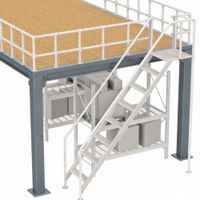Call +(254) 703 030 000 / 751 483 999 / 721 704 777
- Home
- Material Handling
- Ladders Platforms Personnel Lifts
.....Read More
Frequently Asked Questions
What are the different types of ladders and their uses?
Ladders are essential tools for reaching elevated areas, with various types designed for specific tasks and environments.
Step ladders are self-supporting, A-shaped ladders with a flat top for tools and paint cans. They are ideal for household chores, painting, and light construction work. Extension ladders are non-self-supporting and consist of two or more sections that slide past each other to extend their length. They require leaning against a stable surface and are commonly used for exterior house painting, roof work, and gutter cleaning.
Orchard ladders, also known as tripod ladders, have a wide base and a single rear leg, providing stability on uneven terrain. They are primarily used for fruit picking and landscaping. Platform ladders feature a large standing platform at the top, offering a more comfortable and secure workspace for tasks requiring extended periods at height.
Telescoping ladders collapse into a compact size for easy transport and storage, making them suitable for DIY enthusiasts and homeowners with limited space. Articulated ladders, also called multi-position ladders, can be reconfigured into various shapes, such as a step ladder, extension ladder, or scaffold, providing versatility for different jobs.
Each ladder type is engineered with specific safety features and weight capacities, and choosing the right ladder for the job is crucial for ensuring safety and efficiency.
How do you safely use a ladder?
To safely use a ladder, always choose the right type and size for the job, and inspect it for damage before each use. Set the ladder on a firm, level surface, and ensure it's fully extended and locked if it's an extension ladder. Maintain a 4-to-1 ratio, meaning for every four feet of height, the base should be one foot away from the wall. Always face the ladder when climbing or descending, and maintain three points of contact (two hands and one foot, or one hand and two feet). Keep your body centered between the side rails and avoid overreaching. Do not stand on the top two rungs of a stepladder or the top three rungs of an extension ladder. Have someone hold the ladder if possible, especially on uneven surfaces. When working at heights, always wear appropriate safety gear and be aware of your surroundings. Never use a metal ladder near electrical power lines. Following these guidelines will significantly reduce the risk of falls and injuries.
What is the difference between a ladder and a step stool?
A ladder is a portable or fixed structure consisting of two side rails joined at intervals by rungs or steps, used for climbing up or down. Ladders are typically taller and designed for reaching higher elevations, often requiring a stable surface for their base. They come in various types, such as extension ladders, step ladders, and straight ladders, each suited for different tasks and heights.
A step stool, on the other hand, is a smaller, lower, and more compact device, usually with one to three steps. It is designed for reaching objects that are just out of arm's reach or for providing a slight elevation to perform tasks. Step stools are generally more stable and self-supporting than ladders, making them suitable for quick, short-term uses around the house or office. They are also often foldable for easy storage. The main distinction lies in their height, portability, and intended use, with ladders for greater vertical access and step stools for minor elevation needs.
How do you choose the right scaffolding for a project?
Choosing the right scaffolding for a project involves considering several factors to ensure safety, efficiency, and cost-effectiveness. First, assess the project's scope and scale: What is the height and reach required? How much weight will the scaffolding need to support (workers, tools, materials)? This will help determine the type of scaffolding needed, such as system scaffolding (e.g., modular or frame), suspended scaffolding, or rolling scaffolding.
Second, consider the site conditions. Is the ground level and stable, or will it require special foundations? Are there any obstructions or limited access points? Weather conditions can also influence the choice; for instance, strong winds may necessitate additional bracing.
Third, evaluate the duration of the project. For short-term tasks, simpler, quicker-to-erect options might be suitable. For long-term projects, more robust and durable systems that can withstand extended exposure to the elements would be preferable.
Fourth, factor in safety regulations and standards. Different regions and types of work have specific requirements for scaffolding design, erection, and inspection. Ensuring compliance is paramount to prevent accidents.
Fifth, consider the specific tasks to be performed on the scaffolding. Will workers need to move heavy materials? Is there a need for platforms at multiple levels? The type of work will dictate the necessary platform width, load capacity, and access points.
Finally, think about the budget and availability of equipment. While cost is a factor, it should not compromise safety. Consulting with experienced scaffolding suppliers or engineers can help determine the most suitable and cost-effective solution for your specific project needs.
What are the safety regulations for using scaffolding?
Safety regulations for scaffolding typically cover several key areas to ensure the well-being of workers. These include requirements for proper erection by trained personnel, ensuring a stable foundation, and using appropriate materials. Regular inspections are crucial to identify any potential defects or hazards. Scaffolding must also be capable of supporting its maximum intended load without failure. Additionally, workers on scaffolding should use personal protective equipment, such as fall arrest systems, and be trained in safe work practices at height. Clear access and egress points are also essential. Regulations may vary by region, but generally, the focus is on preventing falls, structural collapses, and other accidents that could lead to injuries or fatalities.
How do you properly set up a work platform?
Setting up a work platform properly involves several key steps to ensure safety and efficiency.
First, a thorough site assessment is crucial. This includes checking the ground for stability, levelness, and any potential hazards like uneven terrain, debris, or overhead obstructions (power lines, tree branches). Ensure adequate clearance from walls, structures, and other equipment.
Next, choose the right type of work platform for the job. Options include scissor lifts, boom lifts, scaffolding, or elevated work platforms. Consider the required working height, reach, weight capacity, and the nature of the tasks to be performed. Always verify that the platform is in good working order through pre-use inspections, checking controls, emergency stops, tires/wheels, and structural integrity.
Before deployment, ensure the work area is clear of unauthorized personnel and traffic. If operating outdoors, check weather conditions; strong winds, rain, or ice can compromise stability and safety. If using outriggers or stabilizers, deploy them fully and ensure they are firmly set on stable ground. Use adequate dunnage or pads if necessary to distribute the load.
Finally, ensure all operators are properly trained and certified for the specific equipment being used. They should wear appropriate personal protective equipment (PPE), including hard hats, safety glasses, and fall protection harnesses if required. Maintain clear communication channels, and never exceed the platform's load capacity or compromise its stability by leaning over guardrails or modifying the equipment. Regular inspections and adherence to manufacturer guidelines and local regulations are paramount for safe operation.
What are the benefits of using a personnel lift?
Personnel lifts offer numerous benefits for various tasks requiring elevated access. They significantly enhance safety by providing a stable and secure platform for workers, reducing the risks associated with ladders or scaffolding. Lifts improve efficiency as they allow workers to quickly and easily reach elevated areas, carry tools and materials, and perform tasks more comfortably. This leads to increased productivity and reduced project timelines.
Personnel lifts come in various types, such as scissor lifts, boom lifts, and vertical mast lifts, each designed for specific applications and terrains. This versatility makes them suitable for a wide range of industries, including construction, maintenance, warehousing, and event management. They also offer precise positioning capabilities, allowing workers to reach awkward angles and confined spaces that might be inaccessible by other means. Furthermore, many modern personnel lifts are equipped with features like self-leveling outriggers, emergency descent systems, and interlocks, further boosting operational safety. Their ability to handle heavy loads and provide extended reach makes them indispensable for jobs that require working at height, ultimately leading to a safer, more productive, and cost-effective work environment.
How do you maintain and inspect ladders for safety?
To maintain and inspect ladders for safety, regularly clean them to remove dirt, grease, or other debris that could obscure defects or create slippery surfaces. Store ladders in a dry, protected area away from extreme temperatures and moisture to prevent material degradation. Before each use, visually inspect the ladder for any damage, such as cracks, bends, loose rungs, or corrosion. Check all hardware, including hinges, locks, and feet, to ensure they are secure and functional. Ensure anti-slip feet are present and in good condition. Look for any missing or damaged labels, especially those indicating weight limits or safety warnings. If any defects are found, remove the ladder from service immediately and tag it as "Do Not Use" until it is repaired by a qualified person or replaced. Do not attempt makeshift repairs. Regularly scheduled, thorough inspections should be performed by a competent person to identify less obvious issues and ensure compliance with safety standards. Keep a record of all inspections and maintenance.
What are the weight limits for different types of ladders and scaffolding?
The weight limits for ladders and scaffolding are critical for safety and are regulated by organizations such as OSHA in the United States. Generally, ladders are classified by duty rating. For instance, Type III (light-duty) supports up to 200 lbs, Type II (medium-duty) up to 225 lbs, Type I (heavy-duty) up to 250 lbs, Type IA (extra heavy-duty) up to 300 lbs, and Type IAA (special duty) up to 375 lbs. These ratings include the combined weight of the user and any tools or materials.
Scaffolding has more varied weight limits, typically expressed as a uniformly distributed load (UDL) per square foot. Light-duty scaffolding might support 25 lbs/sq ft, medium-duty 50 lbs/sq ft, and heavy-duty 75 lbs/sq ft. The overall capacity of a scaffold depends on its design, materials, and how it is assembled. Always consult the manufacturer's guidelines and local regulations for specific weight limits and proper usage, as exceeding these limits can lead to structural failure and serious injury.
How do you configure a modular platform system for a specific application?
Configuring a modular platform system for a specific application involves several key steps to ensure optimal performance and functionality.
First, **define the application requirements** comprehensively. This includes identifying the core functions the system needs to perform, specific operational parameters (e.g., speed, precision, payload capacity), environmental conditions (temperature, dust, vibration), and any regulatory compliance or safety standards.
Next, **select appropriate modules** based on these requirements. Modular systems typically offer various components such as structural elements (frames, profiles), motion components (linear actuators, rotary stages), control systems (PLCs, motor controllers), sensors, and end effectors. Choose modules that meet the defined specifications for size, strength, accuracy, and compatibility.
**Design the system layout** using a modular design approach. This often involves CAD software to visualize the arrangement of modules, ensure proper clearances, and optimize for factors like accessibility, footprint, and material flow (if applicable). Consider the interfaces between modules to ensure seamless integration.
**Assemble the physical system** by connecting the selected modules according to the design. This typically involves standardized fasteners, connectors, and mounting hardware that are part of the modular system. Attention to detail during assembly is crucial for structural integrity and precise alignment.
**Integrate and program the control system**. This step involves connecting all electrical components, sensors, and actuators to the control unit. Software development is then performed to program the desired motion profiles, logic sequences, and safety interlocks, tailored to the specific application's operational flow.
Finally, **test and calibrate the system**. Thoroughly test all functionalities, including individual module operation, integrated system performance, and emergency stop procedures. Calibrate sensors and actuators to ensure accuracy and repeatability. Fine-tune parameters to optimize performance and achieve the desired output for the specific application. Documentation of the configuration, wiring diagrams, and software parameters is also vital for future maintenance and troubleshooting.







